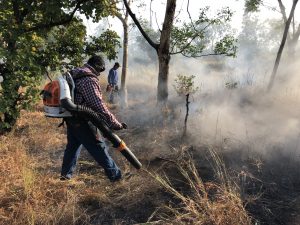
Fire management near the most northern point of Australia on Merepah Station, Cape York Peninsula, is delivering a valuable income stream for the Moompa-Awu Aboriginal Corporation (MAAC) while also assisting the functioning cattle business.
MAAC is the representative body for the Wik Iiyney/Mankanhu people who have a cultural connection to ILSC-owned Merepah Station, west of Coen, Qld. MAAC was formed to hold land, protect culture and the environment, and undertake economic development and land management at the station, including the ILSC-established fire project.
The Merepah Fire Project involves strategic fire management, including aerial and ground burning as well as fire suppression to reduce late dry-season wildfires, in turn decreasing carbon emissions. The project was registered under the Emission Reduction Fund (ERF) in 2014, with the ILSC as the initial ERF project proponent. The project has been issued 89,165 Australian Carbon Credit Units over its five years of operation, providing a consistent source of income. Through this work the ILSC has assisted the group to facilitate a 25 year revenue stream based on the carbon-abatement performance of the project.
The ILSC continues to provide advice and capability support on strategic fire management and operating an ERF savanna fire management project, with MAAC Traditional Owners increasingly involved in training, planning and operations. Revenue from the Merepah Fire Project is helping to fund MAAC business services and the refurbishment of old Merepah Station. Infrastructure developments on the station are being organised and managed by MAAC.
Through MAAC, Traditional Owners have established sound management and governance and have improved job prospects with career pathways, whether as workers in the cattle industry, as rangers protecting cultural or natural assets, or as fire management operators.
